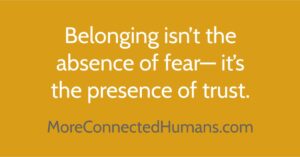We all know what it feels like to hesitate before speaking. You have an idea, a question, or even a concern—but something inside you says, don’t risk it.
Maybe you’ve seen what happens to people who make mistakes. Maybe you’ve been shut down before.
That moment of hesitation is where psychological safety begins—or ends.
In today’s workplaces, many leaders discuss the importance of belonging. But belonging can’t exist without psychological safety. If people don’t feel safe enough to show up, speak honestly, or take risks, then belonging stays surface-level at best.
The Real Stakes of “Safety”
When we talk about risk at work, it’s not theoretical.
People weigh real consequences before they speak:
- Income: “Can I afford to lose favor, hours, or stability?” “Will I lose my job?”
- Reputation: “Will this label me as difficult or disloyal?” “Will I be seen as a leader?”
- Social capital: “Will my peers stop including me if I say this out loud?”
These calculations happen quietly, every day.
And for employees from historically marginalized groups—who may already be navigating bias or exclusion—the stakes can be even higher.
Supervisors face their own pressures, including the expectation to “manage well,” maintain authority, and deliver results. Many are caught between the culture they want to create and the directives they must follow. Without support, they too learn to self-protect—to avoid risk instead of modeling it.
How Supervisors Shape Safety
Psychological safety lives or dies in the daily interactions between supervisors and their teams.
Supervisors hold the immediate power to signal: You’re safe here.
It’s communicated when they:
- Admit, “I don’t have all the answers.”
- Thank someone for honest feedback, even when it’s hard to hear.
- Step in to protect someone who takes a social or professional risk.
When these behaviors are absent, self-protection replaces engagement—and innovation, honesty, and belonging stall.
Professional Development for Risk Tolerance
Organizations often train supervisors in compliance, evaluation, and technical skills—but rarely in relational risk management: how to stay curious under pressure, how to navigate emotions, and how to de-escalate fear.
Building risk tolerance—for both supervisors and employees—requires intentional development:
- For supervisors: coaching in feedback readiness, empathy, and repair skills.
- For employees: learning how to express dissent and disagreement with clarity and care.
- For People & Culture leaders: creating structures that reward transparency, not perfection.
When risk becomes part of the learning process rather than a punishment, culture begins to shift.
Reflection Questions
For Supervisors
- What signals do I send—verbally and nonverbally—about how safe it is to disagree with me?
- How do I respond when someone challenges me or shares something that makes me uncomfortable?
- Where do I rely on authority instead of relationship to maintain order?
- What risks feel hardest for me to take as a leader—and why?
For Employees
- What risks do I take—or avoid—to keep my job, my reputation, or my sense of belonging?
- What would make it safer for me to speak candidly or to make a mistake?
- When have I felt most protected or affirmed by a supervisor? What made that moment possible?
For People & Culture Changemakers
Those working in People & Culture carry the long view. Culture doesn’t shift by policy alone—it shifts through practice and protection. Consider:
- How are supervisors supported to be brave, not just be right?
- How do our systems (evaluation, promotion, feedback) reinforce or reduce risk-taking?
- Where does our organization reward conformity instead of curiosity?
- What would it look like if psychological safety were as measurable as performance?
Belonging isn’t the absence of fear—it’s the presence of trust.
When supervisors are equipped and employees are protected, workplaces can evolve into communities where honesty and humanity coexist.
That’s the work we’re committed to at More Connected Humans™: helping organizations grow their capacity for connection, courage, and care—so safety and belonging are not perks, but daily experiences. Reach out if we can help!
Eva, MCH

